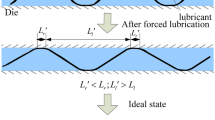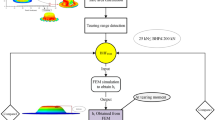Abstract
Due to the difference in velocity of metal flow between the corner area and the straight edge area of the flange during box-shaped part drawing, the resulting induced shear stress leads to uneven deformation. In the present research, a zoned lubrication process based on forced lubrication technology for box-shaped part deep drawing is proposed. The lubrication conditions in various areas in the flange area can be adjusted individually to improve metal flow. The pressurized lubricant is flushed into the contact gap between the sheet metal and the dies by the hydraulic pump. The oil discharge grooves machined on the die surface divide the flange area into straight edge area and corner area, and each area is supplied with oil independently to achieve the purpose of zoned lubrication by reasonably regulating the oil flow parameters. The evaluation indexes of deformation uniformity with strain and thickness variation rate (TVR) as reference variables are established to qualitatively and quantitatively evaluate the deformation uniformity. The tests of zoned lubrication drawing process for box-shaped parts were carried out under different loading paths. The results demonstrate that the uniformity evaluation indexes have a decreasing trend after zoned lubrication, reflecting that the deformation uniformity has been improved. In addition, the surface morphology and thickness variation of the formed parts both demonstrate the positive effect of forced lubrication. The feasibility and effectiveness of the proposed process are verified. It has certain guiding significance for improving the overall forming quality in the actual production of the parts with complex structures.













Similar content being viewed by others
Data availability
All data calculated or analyzed during this research are included in this article.
References
El Mrabti I, Touache A, El Hakimi A, Chamat A (2021) Springback optimization of deep drawing process based on FEM-ANN-PSO strategy. Struct Multidiscip Optim 64(1):321–333
Rivas-Menchi A, Medellin-Castillo HI, de Lange DF, Garcia-Zugasti PD (2018) Performance evaluation of analytical expressions for cylindrical and rectangular deep drawing force estimation. J Manuf Process 36:340–350
Bao ZP, Li F, Jin CC (2018) Investigations on deformation behavior of square box deep drawing using a magnetorheological fluid (MRF). Int J Adv Manuf Technol 99(5–8):1459–1466
Ahmetoglu MA, Altan T, Kinzel GL (1992) Improvement of part quality in stamping by controlling blank-holder force and pressure. J Mater Process Technol 33(1–2):195–214
Siegert K, Wagner S, Ziegler M (1996) Closed loop binder force system. Int Cong Expo 143
Siegert K, Ziegler M, Wagner S (1997) Closed loop control of the friction force. Deep drawing process. J Mater Process Technol 71(1):126–133
Hassan MA, Hino K, Takakura N, Yamaguchi K (2002) Friction aided deep drawing of sheet metals using polyurethane ring and auxiliary metal punch. Part 2: analysis of the drawing mechanism and process parameters. Int J Mach Tools Manuf 42(5):633–642
Hassan MA, Takakura N, Yamaguchi K (2003) Friction aided deep drawing using newly developed blank-holder divided into eight segments. Int J Mach Tools Manuf 43(6):637–646
Hassan MA, Ahmed KIE, Takakura N (2012) A developed process for deep drawing of metal foil square cups. J Mater Process Technol 212(1):295–307
Tommerup S, Endelt B (2012) Experimental verification of a deep drawing tool system for adaptive blank holder pressure distribution. J Mater Process Technol 212(11):2529–2540
Endelt B, Tommerup S, Danckert J (2013) A novel feedback control system - controlling the material flow in deep drawing using distributed blank-holder force. J Mater Process Technol 213(1):36–50
Zhang HS, Qin SJ, Cao LQ (2021) Investigation of the effect of blank holder force distribution on deep drawing using developed blank holder divided into double rings. J Braz Soc Mech Sci Eng 43(6):284
Kaftanoǧlu B (1973) Determination of coefficient of friction under conditions of deep-drawing and stretch forming. Wear 25(2):177–188
Tan CJ, Aslian A, Abe Y, Mori K (2016) Improved seizure resistance of ultra-high-strength steel ironed cups with a lubricant containing SiO2 nanoparticles. Int J Adv Manuf Technol 87(5–8):1705–1711
Diabb J, Rodriguez CA, Mamidi N, Sandoval JA, Taha-Tijerina J, Martinez-Romero O, Elias-Zuniga A (2017) Study of lubrication and wear in single point incremental sheet forming (SPIF) process using vegetable oil nanolubricants. Wear 376:777–785
Kamali H, Xie HB, Jia FH, Wu H, Zhao HY, Zhang HM, Li N, Jiang ZY (2019) Effects of nano-particle lubrication on micro deep drawing of Mg-Li alloy. Int J Adv Manuf Technol 104(9–12):4409–4419
Wang CJ, Wang CJ, Guo B, Shan DB (2014) Effects of tribological behavior of DLC film on micro-deep drawing processes. Trans Nonferrous Met Soc China 24(9):2877–2882
Sulaiman MH, Farahana RN, Bienk K, Nielsen CV, Bay N (2019) Effects of DLC/TiAlN-coated die on friction and wear in sheet-metal forming under dry and oil-lubricated conditions: experimental and numerical studies. Wear 438–439:203040
Basavaraj V, Shekhawat SK, Narasimhan K, Samajdar I (2015) Constrained tensile stretching of steel strips under different lubrication: predicting macroscopic strain distributions with microstructural inputs. Int J Mater Form 8(2):327–339
Zhang L, Min JY, Carsley JE, Stoughton TB, Lin JP (2017) Experimental and theoretical investigation on the role of friction in Nakazima testing. Int J Mech Sci 133:217–226
Wang XY, Li JB, Deng L, Li JJ (2018) Metal flow control during hot forming of square cups with local-thickened plates and varied friction conditions. J Mater Process Technol 253:195–203
Phanitwong W, Sriborwornmongkol J, Thipprakmas S (2021) Zoning lubricant die application for improving formability of box-shaped deep drawn parts. Metals 11(7):1015
Fukui S, Yoshida K (1954) The scale effects on deep drawing of circular shells. Report of Science and Technology Institute. University of Tokyo 8:23–30
Lange K, Mc Graw H (1985) Handbook of metal forming. New York
Acknowledgements
The authors would like to thank the staff of Forging and Packaging laboratory (Yanshan University) for their great help and suggestions in the experiments.
Author information
Authors and Affiliations
Contributions
Methodology: Duan Chen and Changcai Zhao; experimental work: Duan Chen and Xiaoyi Chen; data analysis: Duan Chen and Guang Chen; writing and editing: Duan Chen and Changcai Zhao. All authors have read and agreed to the published version of the manuscript.
Corresponding author
Ethics declarations
Competing interests
The authors declare no competing interests.
Additional information
Publisher's Note
Springer Nature remains neutral with regard to jurisdictional claims in published maps and institutional affiliations.
Rights and permissions
Springer Nature or its licensor holds exclusive rights to this article under a publishing agreement with the author(s) or other rightsholder(s); author self-archiving of the accepted manuscript version of this article is solely governed by the terms of such publishing agreement and applicable law.
About this article
Cite this article
Chen, D., Zhao, C., Chen, X. et al. Research on the zoned lubrication process based on forced lubrication technology during box-shaped part deep drawing. Int J Adv Manuf Technol 123, 1099–1110 (2022). https://doi.org/10.1007/s00170-022-10241-z
Received:
Accepted:
Published:
Issue Date:
DOI: https://doi.org/10.1007/s00170-022-10241-z




